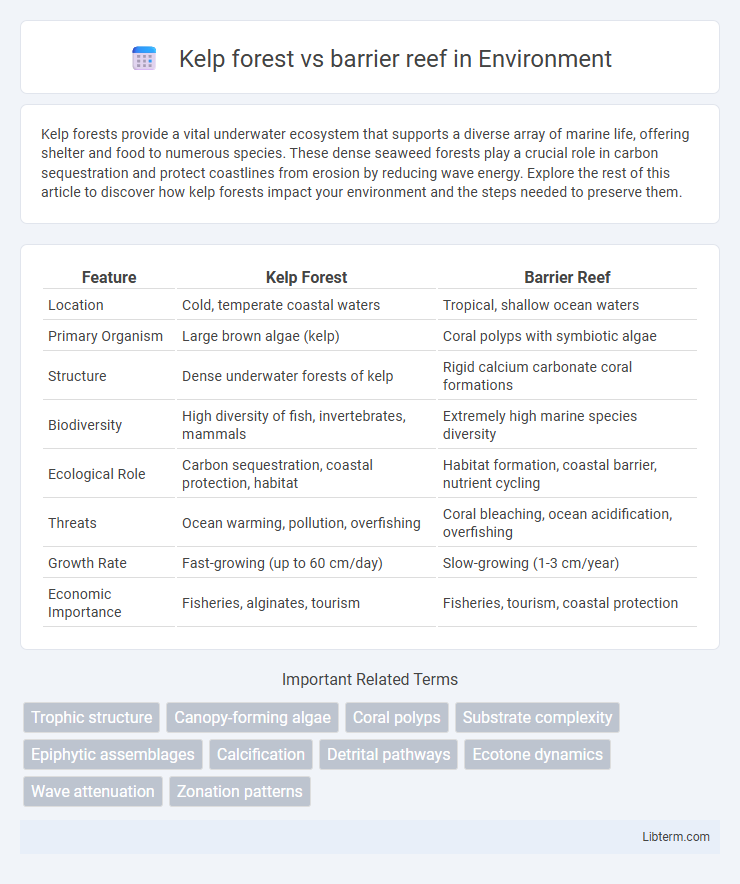Kelp forests provide a vital underwater ecosystem that supports a diverse array of marine life, offering shelter and food to numerous species. These dense seaweed forests play a crucial role in carbon sequestration and protect coastlines from erosion by reducing wave energy. Explore the rest of this article to discover how kelp forests impact your environment and the steps needed to preserve them.
Table of Comparison
| Feature | Kelp Forest | Barrier Reef |
|---|---|---|
| Location | Cold, temperate coastal waters | Tropical, shallow ocean waters |
| Primary Organism | Large brown algae (kelp) | Coral polyps with symbiotic algae |
| Structure | Dense underwater forests of kelp | Rigid calcium carbonate coral formations |
| Biodiversity | High diversity of fish, invertebrates, mammals | Extremely high marine species diversity |
| Ecological Role | Carbon sequestration, coastal protection, habitat | Habitat formation, coastal barrier, nutrient cycling |
| Threats | Ocean warming, pollution, overfishing | Coral bleaching, ocean acidification, overfishing |
| Growth Rate | Fast-growing (up to 60 cm/day) | Slow-growing (1-3 cm/year) |
| Economic Importance | Fisheries, alginates, tourism | Fisheries, tourism, coastal protection |
Introduction to Kelp Forests and Barrier Reefs
Kelp forests, primarily found in cold, nutrient-rich coastal waters, consist of large brown algae that create complex underwater ecosystems supporting diverse marine life. Barrier reefs, predominantly located in warm, shallow tropical oceans, are extensive coral formations that protect coastlines and provide habitats for numerous species. Both kelp forests and barrier reefs play crucial roles in marine biodiversity, carbon sequestration, and coastal protection.
Geographic Distribution and Locations
Kelp forests predominantly thrive in cold, nutrient-rich waters along the coasts of the Pacific Northwest, California, and parts of South America, while barrier reefs are primarily found in warm, shallow waters such as the Great Barrier Reef off Australia and the Caribbean Sea. Kelp forests typically grow in temperate zones with rocky substrates, contrasting with barrier reefs that develop in tropical to subtropical regions with clear, sunlit waters suitable for coral growth. The geographic distribution of kelp forests is concentrated in higher latitudes, whereas barrier reefs are characteristic of equatorial and subequatorial marine environments.
Key Environmental Requirements
Kelp forests require cold, nutrient-rich waters typically found along temperate coastlines, relying on rocky substrates for attachment and sufficient sunlight for photosynthesis. Barrier reefs thrive in warm, shallow, clear tropical waters with stable salinity and low nutrient levels, depending on calcium carbonate to build their extensive limestone structures. Both ecosystems demand specific temperature ranges and water quality to support their diverse marine life and maintain ecological balance.
Structural Differences and Habitat Complexity
Kelp forests consist of dense, towering brown algae forming underwater forests that provide vertical structure and diverse habitats for marine species, whereas barrier reefs are massive coral formations creating rigid, calcium carbonate frameworks with intricate crevices and coral colonies. The flexible, layered kelp canopy supports a variety of fish and invertebrates, while the solid, complex architecture of barrier reefs sustains diverse coral assemblages and reef fish communities. Structural differences influence habitat complexity, with kelp forests offering dynamic, seasonal cover and barrier reefs providing long-lasting, solid habitats critical for reef biodiversity.
Dominant Species and Biodiversity
Kelp forests are dominated by large brown algae, primarily giant kelp (Macrocystis pyrifera), which create complex three-dimensional habitats supporting diverse marine species such as sea urchins, fish, and invertebrates. Barrier reefs, particularly the Great Barrier Reef, are dominated by stony corals like Acropora spp., forming rigid calcium carbonate structures that host extensive biodiversity with thousands of fish species, mollusks, and crustaceans. Both ecosystems exhibit high biodiversity, but kelp forests support more temperate species while barrier reefs harbor tropical marine life adapted to warm, clear waters.
Ecological Roles and Ecosystem Services
Kelp forests provide critical habitat and food sources for numerous marine species, supporting biodiversity and acting as nurseries for fish and invertebrates, while also sequestering carbon and protecting shorelines from erosion. Barrier reefs, such as the Great Barrier Reef, offer complex three-dimensional structures that enhance marine biodiversity, support fisheries, and serve as natural breakwaters reducing wave impact on coastal communities. Both ecosystems contribute essential ecosystem services, including nutrient cycling, carbon storage, and supporting tourism industries vital for local economies.
Threats and Environmental Challenges
Kelp forests face significant threats from rising ocean temperatures and ocean acidification, which disrupt their growth and lead to habitat loss for marine species. Barrier reefs encounter severe challenges from coral bleaching caused by increased sea temperatures, pollution, and overfishing, resulting in decreased biodiversity and reef degradation. Both ecosystems suffer from climate change impacts and human activities that threaten their ecological stability and resilience.
Conservation Efforts and Strategies
Kelp forest conservation efforts prioritize protection through establishing marine protected areas and implementing sustainable harvesting practices to maintain biodiversity and ecosystem resilience. Barrier reef preservation strategies emphasize coral reef restoration, water quality management, and combating climate change impacts such as coral bleaching and ocean acidification. Both ecosystems benefit from community engagement, scientific monitoring, and policy enforcement to enhance their long-term survival.
Economic and Cultural Importance
Kelp forests generate over $1 billion annually through fisheries and tourism, supporting coastal communities with sustainable seafood and recreational opportunities. Barrier reefs contribute approximately $375 billion worldwide by protecting shorelines, fostering biodiversity, and sustaining fishing industries vital to local economies. Both ecosystems hold profound cultural significance, with indigenous peoples relying on kelp forests for traditional practices and barrier reefs symbolizing spiritual heritage and community identity.
Future Outlook and Sustainability
Kelp forests face threats from ocean warming and acidification, but restoration projects and sustainable fishing practices offer potential for recovery and resilience. Barrier reefs, particularly the Great Barrier Reef, are vulnerable to coral bleaching and pollution, yet advances in coral farming and marine protected areas aim to enhance their sustainability. Both ecosystems require continued global commitment to climate action and habitat preservation to ensure their future viability.
Kelp forest Infographic

 libterm.com
libterm.com